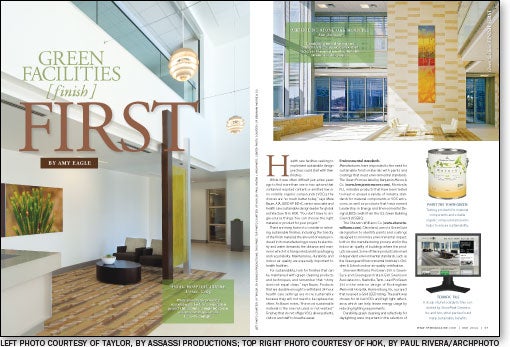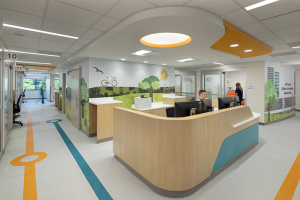Green facilities finish first
Green facilities finish first (PDF)
Health care facilities seeking to implement sustainable design practices could start with their finishes.
While it was often difficult just a few years ago to find more than one or two options that contained recycled content or emitted low or no volatile organic compounds (VOCs), the choices are "so much better today," says Mara Baum, AIA, LEED AP BD+C, senior associate and health care sustainable design leader for global architecture firm HOK. "You don't have to single-source things. You can choose the right material or product for your project."
There are many factors to consider in selecting sustainable finishes, including: the toxicity of the finish material; the amount of waste produced in its manufacturing process; its electricity and water demands; the distance and manner in which it is transported; and its packaging and recyclability. Maintenance, durability and indoor air quality are especially important to health facilities.
For sustainability, look for finishes that can be maintained with green cleaning products and techniques, and remember that "shiny does not equal clean," says Baum. Products that are durable enough to withstand 24-hour health care settings are more sustainable because they will not need to be replaced as often. As Baum notes, "the most sustainable material is the one not used, or not wasted." Finishes that do not offgas VOCs allow patients, visitors and staff to breathe easier.
Environmental standards
Manufacturers have responded to the need for sustainable finish materials with paints and coatings that meet environmental standards. The Green Promise label by Benjamin Moore & Co. (www.benjaminmoore.com), Montvale, N.J., indicates products that have been tested to meet or exceed a variety of industry standards for material components or VOC emissions, as well as products that have earned Leadership in Energy and Environmental Design (LEED) credits from the U.S. Green Building Council (USGBC).
The Sherwin-Williams Co. (www.sherwin-williams.com), Cleveland, uses its GreenSure designation to identify paints and coatings designed to minimize environmental impact, both in the manufacturing process and in the indoor air quality of buildings where the products are used. Some of these products also meet independent environmental standards, such as the Greenguard Environmental Institute's Children & Schools indoor air-quality certification.
Sherwin-Williams ProGreen 200 is GreenSure and Greenguard rated. Earl Swensson Associates Inc., Nashville, Tenn., used ProGreen 200 in the interior design of Rockingham Memorial Hospital, Harrisonburg, Va., a project that received a Gold LEED rating. The paint was chosen for its low VOCs and high light reflectance, which can help lessen energy usage by reducing lighting requirements.
Durability, green cleaning and reflectivity for daylighting were important in the selection of sustainable finishes for several recent and ongoing HOK health care projects, Baum says. These include Methodist Stone Oak Hospital, San Antonio, and The Ohio State University (OSU) Medical Center, Columbus.
With the support of the Environmental Protection Agency, the OSU Medical Center and College of Engineering are researching the sustainability benefits of a major expansion project underway on the medical center campus. The study, known as the Value Assessment for Sustainable Technologies, is led by the OSU Center for Resilience, a multidisciplinary research center. According to Baum, extensive daylighting studies have been undertaken to select the optimal glass type, room depths and finishes for the project.
Interior finishes with substantial recycled content and low VOC-emitting materials helped put the newly opened Osher Center for Integrative Medicine at the University of California, San Francisco, on track to earn LEED Silver certification. Designers from the San Francisco office of KMD Architects also used the building's finishes to express the feng shui principles embodied in the facility, where modern medicine is performed alongside established health care practices from around the world. Blue walls signify healing and calmness while beige walls represent the centralized, grounded atmosphere of earth.
Innovative finish materials
Finishes played a significant role in the sustainable design of Hoag Hospital Irvine (Calif.), a LEED Silver-certified facility. Newport Beach, Calif., architecture, planning and interior design firm Taylor renovated the former Irvine Regional Hospital and Medical Center building to create the new hospital. Robert Braithwaite, Hoag Hospital's chief administrative officer, has said that in effect, the project "recycled the hospital."
In the renovation, spaces were simplified and some plaster walls were replaced with glass, increasing the amount of daylight in the building. White paint magnifies this light and helps give the building a contemporary look.
Active Clean Air & Antibacterial Ceramic (www.active-ceramic.com) floor tiles in the lobby and public restrooms are manufactured with a titanium dioxide application that provides air-purifying and antibacterial qualities. The manufacturing process takes advantage of the photocatalytic properties of titanium dioxide. When exposed to light, this material oxidizes harmful organic and inorganic substances. Research of photocatalytic tiles conducted by the Tile Council of North America; Centro Ceramico (www.cencerbo.it), Bologna, Italy; and StonePeak Ceramics Inc. (www.stonepeakceramics.com), Chicago, found a 70 percent reduction in nitrogen oxides, a major form of urban pollution; an up to 99 percent reduction of Escherichia coli, Staphylococcus aureus and Klebsiella pneumoniae bacteria; and an average 30 percent reduction of organic pollutants.
In the design of the new Bellevue (Neb.) Medical Center — which is targeted for LEED Silver certification — HDR Architecture, Omaha, Neb., used textile glass wallcovering manufactured by German firm Vitrulan GmbH (www.vitrulanusa.com). Vitrulan is made from abundant natural quartz, contains no plasticizers, is chlorine-free and emits low VOCs. This material is also impact-resistant, seamless, scrubbable and highly water vapor-permeable, making it well-suited to health care environments.





